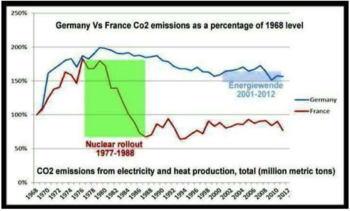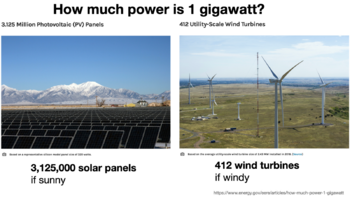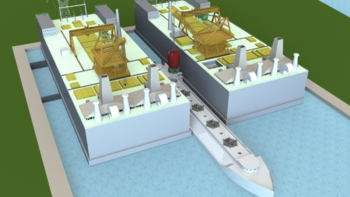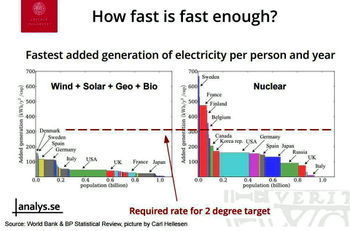Energy policy and global warming: Difference between revisions
Jump to navigation
Jump to search

No edit summary |
No edit summary |
||
| Line 1: | Line 1: | ||
{{subpages}} | {{subpages}} | ||
{{seealso|Nuclear_power_reconsidered}} | {{seealso|Nuclear_power_reconsidered}} | ||
{{Image|WorldElectricPower2021.png|right|350px|World electric power consumption in 2021 - 3030 GW.}} | {{Image|WorldElectricPower2021.png|right|350px|World electric power consumption in 2021 - 3030 GW. This may soon double, mostly from added coal plants in the developing world.}} | ||
{{Image|Electrified World Power Flow.png|right|350px|A | {{Image|Electrified World Power Flow.png|right|350px|Electric power generation is only a third of our CO2 problem. A zero-carbon future should include industry and transportation.}} | ||
{{Image|Large grids low carbon.png|right|350px|Success requires abundant hydropower or nuclear, available 24/7.}} | {{Image|Large grids low carbon.png|right|350px|Success requires abundant hydropower or nuclear, available 24/7.}} | ||
{{Image|Germany France CO2.png|right|350px|Wind and solar alone are not enough.}} | {{Image|Germany France CO2.png|right|350px|Wind and solar alone are not enough.}} | ||
{{Image|Electrify1Basics.022.png|left|350px|Wind and solar to power the whole world will require unrealistic commitments of land and resources.}} | {{Image|Electrify1Basics.022.png|left|350px|Wind and solar to power the whole world will require unrealistic commitments of land and resources.}} | ||
{{Image|ThorCon Plant.png|left|350px|Two 500 MW ThorCons and a can ship powered by four 250 MW Small Modular Reactors.}} | |||
{{Image|Countries CO2 targets.jpg|left|350px|Time is short, and build rate is critical to meet our goals.}} | {{Image|Countries CO2 targets.jpg|left|350px|Time is short, and build rate is critical to meet our goals.}} | ||
{{Image|Low-carbon-share-energy.png|left|350px|Few countries are now on track.}} | {{Image|Low-carbon-share-energy.png|left|350px|Few countries are now on track.}} | ||
National energy policies have had a profound effect on success in reducing CO2 emissions. Some countries have made substantial progress in meeting the goals they have agreed to. Very few are moving fast enough to limit global warming to 2 degrees C. This article will examine the results of these national policies. | National energy policies have had a profound effect on success in reducing CO2 emissions. Some countries have made substantial progress in meeting the goals they have agreed to. Very few are moving fast enough to limit global warming to 2 degrees C. This article will examine the results of these national policies. | ||
Revision as of 04:17, 25 May 2022
- See also: Nuclear_power_reconsidered
File:Low-carbon-share-energy.png
Few countries are now on track.
National energy policies have had a profound effect on success in reducing CO2 emissions. Some countries have made substantial progress in meeting the goals they have agreed to. Very few are moving fast enough to limit global warming to 2 degrees C. This article will examine the results of these national policies.






